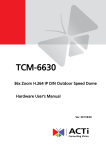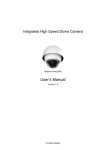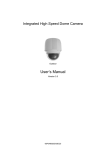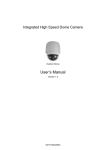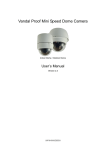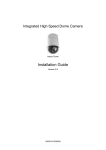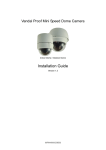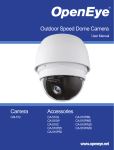Download GANZ PTZ User Manual_30x/36x
Transcript
f English Version 1.1 User’s Manual Preface The information provided in this manual was current when published. The company reserves the right to revise and improve its products. All specifications are subject to change without notice. Notice To work with the PTZ Cameras, any installer or technician must have the following minimum qualifications: • A basic knowledge of CCTV systems and components • A basic knowledge of electrical wiring and low-voltage electrical connections • Thorough familiarity with the contents of this manual Important Information Before proceeding, please read and observe all instructions and warnings in this manual. Retain this manual with the original bill of sale for future reference and, if necessary, warranty service. When unpacking your unit, check for missing or damaged items. If any item is missing, or if damage is evident, DO NOT INSTALL OR OPERATE THIS PRODUCT. Contact your dealer for assistance. Copyright Under copyright laws, the contents of this user manual may not be copied, photocopied, translated, reproduced or replicated in any electronic medium or machine-readable format, in whole or in part, without the prior written permission of CBC Co. Ltd. ©Copyright2006CBC Co. Ltd. Regulation This device complies with Part 15 of the FCC Rules. Operation is subject to the following two conditions: (1) this device may not cause harmful interference, and (2) this device must accept any interference received, including interference that may cause undesired operation. 1 User’s Manual Disposal of your old appliance 1. When this crossed-out wheeled bin symbol is attached to a product it means the product is covered by the European Directive 2002/96/EC. 2. All electrical and electronic products should be disposed of separately from the municipal waste stream via designated collection facilities appointed by the government or the local authorities. 3. The correct disposal of your old appliance will help prevent potential negative consequences for the environment and human health. 4. For more detailed information about disposal of your old appliance, please contact your city office, waste disposal service or the shop where you purchased the product 2 User’s Manual Warning Notices • Handle the camera with care Do not abuse the camera. Avoid striking, shaking, etc. The camera could be damaged by improper handing or storage. • Do not dismantle the camera To prevent electric shock, do not remove screws or covers. There are no user serviceable parts inside. Contact a qualified service person for servicing. • Do not block cooling holes on the bracket This camera has a cooling fan inside. Blocking the cooling holes leads to a build up of heat inside the camera and may cause malfunctions. • Do not operate the camera outside the specified temperature, humidity or power source rating range Use the indoor camera under conditions where the temperature is between 0~ 40°C (32 ~104°F) and the outdoor camera at -50~ 50° C (-58 ~122°F) and in humidity of below 90%. • Do not use strong or abrasive detergents when cleaning the camera body Use a dry cloth to clean the camera when dirty. If the dirt is hard to remove, use a mild detergent and wipe gently. • Never point the camera towards the sun Do not aim the camera at bright objects. Whether the camera is in use or not, never aim it at the sun or other extremely bright objects. Otherwise, the camera may be smeared or damaged. 3 User’s Manual Table of Contents 1. Overview .................................................................................................................................. 6 1.1 Product Features ........................................................................................................... 7 1.2 Product Application........................................................................................................ 8 2. Connecting the PTZ Camera .................................................................................................. 9 2.1 Package Content ........................................................................................................... 9 2.2 Switch/Connector Definition......................................................................................... 11 2.3 Communication Switch Setting .................................................................................... 11 2.4 PTZ Camera ID Setting ............................................................................................... 12 2.5 PTZ Camera Control Protocol...................................................................................... 13 2.6 22-Pin Connector Definition ......................................................................................... 14 2.7 RS-485 Connector....................................................................................................... 15 3. Operation and Configuration................................................................................................ 16 3.1 OSD Display Format.................................................................................................... 16 3.2 OSD Menu Tree........................................................................................................... 17 3.2.1 3.3 18×/30×/36× Model ........................................................................................ 17 Configuration Menu ..................................................................................................... 20 3.3.1 LANGUAGE ................................................................................................... 20 3.3.2 DEFAULT CAMERA ....................................................................................... 21 3.3.3 BACKLIGHT................................................................................................... 21 3.3.4 FOCUS .......................................................................................................... 22 3.3.5 AE MODE ...................................................................................................... 23 3.3.6 WBC MODE................................................................................................... 24 3.3.7 SETUP MENU 1............................................................................................. 25 ZOOM SPEED ............................................................................................... 25 DIGITAL ZOOM.............................................................................................. 25 SLOW SHUTTER........................................................................................... 25 DIGITAL NOISE REDUCTION ....................................................................... 26 IMAGE INVERSE........................................................................................... 26 FREEZE......................................................................................................... 26 APERTURE ................................................................................................... 27 EXIT............................................................................................................... 27 3.3.8 SETUP MENU 2............................................................................................. 28 FLIP ............................................................................................................... 28 ANGLE ADJUSTER ....................................................................................... 29 SPEED BY ZOOM ......................................................................................... 29 AUTO CALI. (Auto Calibration)....................................................................... 29 PASSWORD .................................................................................................. 29 OSD AUTO CLOSE........................................................................................ 30 SYSTEM RESET ........................................................................................... 30 4 User’s Manual EXIT............................................................................................................... 30 3.3.9 ID DISPLAY ................................................................................................... 31 3.3.10 TITLE DISPLAY ............................................................................................. 31 3.3.11 TITLE SETTING............................................................................................. 31 3.3.12 PRESET ........................................................................................................ 32 3.3.13 SEQUENCE................................................................................................... 33 3.3.14 AUTOPAN...................................................................................................... 35 3.3.15 CRUISE ......................................................................................................... 37 3.3.16 HOME SETTING............................................................................................ 38 3.3.17 IR FUNCTION (Removable IR Blocking) ........................................................ 40 3.3.18 ALARM SETTING .......................................................................................... 40 3.3.19 ALARM DETECT ........................................................................................... 43 3.3.20 WDR FUNCTION ........................................................................................... 45 3.3.21 PRIVACY MASK ............................................................................................ 45 3.3.22 TIME SETTING .............................................................................................. 47 3.3.23 SCHEDULE ................................................................................................... 48 3.3.24 EXIT OSD ...................................................................................................... 49 Appendix A: Technical Specifications ....................................................................................... 50 OSD Menu Notes......................................................................................................................... 52 5 User’s Manual 1. Overview The ZC-PT series integrated indoor PTZ Camera is a new sub-compact model designed to deliver superb performance and durability combined with an intelligent and stylish housing that is suitable for any security and surveillance installation. The ZC-PT-XT series is a new weather resistant integrated outdoor PTZ Camera. The ZC-PT and ZC-PT-XT series support a standard wiring concept for easy installation, and can be integrated with CCTV products, such as DVRs, control keyboards and CCTV accessories to provide a total surveillance solution. The PTZ Camera range includes three models of new generation advanced DSP colour cameras: ZC-PT236 Model: 36× optical zoom / 12× digital magnification ZC-PT230 Model: 30× optical zoom / 12× digital magnification ZC-PT218 Model: 18× optical zoom / 12× digital magnification The PTZ Camera delivers up to 432x zoom ratio, enabling it to capture clear images from a long distance away. Continuous auto focus, back light compensation, auto exposure, and digital slow shutter functions ensure clear and high quality images. The key features incorporated to meet your needs include a removable IR blocking filter to 24-hour operation, additional privacy masks specially designed to prevent any intrusive monitoring in specific areas, and Wide Dynamic Range function. The Home function allows the user to specify a preset position as the ‘home position’ or a default function (sequence/auto-pan/cruise) as ‘home function’. The PTZ Camera will automatically return to its home position or function when the user does not operate any of the controls for a set period of time. The unique scheduling function also enables users to program a preset point or function (Sequence/Auto-Pan/Cruise), which is automatically triggered at a certain time. The PTZ Camera provides variable pan/tilt speeds ranging from a fast patrol of 400° per second to a slow sweep of 5° per second with 0. 225° pan accuracy for fast and accurate tracking capability. The 360° continuous r otation and -10°~190° tilt travel capabilities allow an object passing directly underneath the PTZ Camera to be tracked. Up to 256 preset points can be programmed for immediate surveillance of target areas, and users can define Sequence lines, Auto-Pan lines and 1Cruise routes for the camera to operate automatically. In addition, RS-485 communication port is available for remote control purposes. The PTZ Camera provides 8 alarm inputs and 1 alarm output, and the smart alarm management mechanism can be programmed using the OSD setup menu; certain functions (Preset/Sequence/Auto-Pan/Cruise) can be activated when an alarm is triggered. 6 User’s Manual Various built-in protocols including Ganz-PT, Ganz-S, Pelco, VCL, Philips, AD-422 (Manchester) etc., provide connectivity to other surveillance systems, allowing the integrated PTZ Camera to be used in conjunction with systems from other manufacturers. Dependability and ultra high reliability are key factors of the camera design. Every PTZ Camera is assembled with meticulous care and thorough testing at our ISO 9001 certified factory. High performance, reliability, and reasonable pricing make this camera an ideal solution for even the toughest surveillance requirements. 1.1 Product Features Precise and Accurate Performance • Auto Calibration • Preset accuracy of 0.225° • Preset speed up to 400°/sec. • Proportional Pan & Tilt Speed • Preset Position/Sequence /Auto-Pan /Cruise Dynamic Applications • Multi-language OSD • Schedule function • Multiple built-in Protocols • Up to 16 masking zones (Optional) • 8 alarm inputs, 1 alarm output • Motion Detection • Flexible indoor/outdoor mountings • Compact lightweight design for easy installation • Weather resistant housing • All-in-one type Superior Camera Image Quality • Minimum illumination 0.01 Lux (B/W) • Digital Slow Shutter • Electronic Shutter • Wide Dynamic Range • Auto White Balance • Backlight Compensation • Auto Exposure • Image Inverse • Removable IR blocking filter 7 User’s Manual 1.2 Product Application Connect the PTZ Camera to other devices as shown in the diagram to create a complete video surveillance solution. NOTE: To extend the network distance up to 1.2 km (4000 feet) and to protect the connected devices, it is highly recommended to place a repeater at the mid-point. However, a repeater may be needed in the network distance less than 1.2 km if the used cables are not the CAT 5 24-gauge cables (see 2.7 RS-485 Connector). Refer to the repeater user manual for detailed information. 8 User’s Manual 2. Connecting the PTZ Camera Please refer to the sections below for details of how to set and connect the PTZ Camera. In order to control PTZ Camera, a control keyboard or alternative control device is required. 2.1 Package Content Before proceeding, please check that the box contains the items listed here. If any item is missing or has defects, DO NOT install or operate the product and contact your dealer immediately for assistance. Indoor PTZ Camera Standard Package Camera Body Hard Ceiling Mount Fixing Plate Optical Cover Installation Guide CD and Decoration Ring Cable for Power, Video, RS-485 and Alarm 9 Power Cord & Quick Guide User’s Manual Outdoor PTZ Camera Standard Package Camera Body & Screws Vandal Proof Cover Lubricant Security screw Water-proof rubber set Cable for Power, Video, RS-485 Power Cord Installation Guide & Quick Guide and Alarm CD 10 User’s Manual 2.2 Switch/Connector Definition The PTZ Camera’s ID and communication protocol must be configured before connecting the camera to other devices. The switches used to configure these settings are located on the bottom of the PTZ Camera. Indoor PTZ Camera 2.3 Outdoor PTZ Camera A Camera Control Protocol Switch B Communication Switch C None D 22-Pin Connector E ID Switch F Reserved G ISP Connector (for FW upgrade) Communication Switch Setting The table below shows the function of each pin within the communication switch. Communication switch SW 1 SW 2 RS-485 setting SW 3 Termination SW 4 Line lock SW 5 Factory Default Reset SW 6 Reserved RS-485 is the interface that allows the PTZ Camera to communicate with its control unit; the RS-485 configuration on the PTZ Camera and the control unit must therefore be the same. The default RS-485 setting is half-duplex. Please do not change the 11 User’s Manual default setting without seeking the advice of a qualified specialist or the supplier. The SW 3 and SW 4 are used for termination and line lock adjustment respectively. The SW 5 is mainly used when users want to restore the camera to the factory default status; moreover, once firmware upgrade is carried out, users also need to reset the SW 5 afterward. RS-485 setting Full-duplex Half-duplex 2.4 PTZ Camera ID Setting Use the switch to change your PTZ Camera ID by turning the arrow to the desired number. For example, if the camera ID is 123, the ID switch should be set as below. NOTE: No two cameras should be given the same ID, or communication conflict may occur. Hundreds Tens Units NOTE: The number “0” should be located at the top as shown in the diagram above to ensure correct switch definition. 12 User’s Manual 2.5 PTZ Camera Control Protocol A protocol is a specific set of rules and procedures used for data communication. Define the protocol you are going to use based on the devices in your surveillance system. Generally, you should use a single protocol even if the devices are supplied by different manufacturers. Use the switch to set your PTZ Camera control protocol and the baud rate. Refer to the table below and turn the arrow to choose a protocol for your camera. Switch no. Protocol Baud rate 00 VCL 9600 01 Pelco D 2400 02 Pelco P 4800 04 Chiper 9600 05 Philips 9600 07 GANZ-PT 9600 08 AD422 4800 09 DM P 9600 11 Pelco D 4800 12 Pelco D 9600 13 Pelco P 2400 14 Pelco P 9600 15 JVC 9600 16 GANZ-S 4800 17 GANZ-S 9600 18 GANZ-S 19200 19 GANZ-S 38400 21 KALATEL RS485 9600 22 KALATEL RS422 4800 *GANZ-PT is for ZC-PT series PTZ Camera. GANZ-S is for ZC-S series PTZ Camera. For example, select protocol Pelco D with a baud rate of 2400, the protocol switch should be set as shown below. Tens 13 Units User’s Manual NOTE: Change the PTZ Camera’s control protocol only when the camera is powered off. After changing protocol, please do the following procedure: (1) Set SW 5 (Communication switch) on. (2) Power on the camera and check the message on the screen. (3) Power off and set SW 5(Communication switch) off. (4) Power on again. 2.6 22-Pin Connector Definition A data cable (as shown below) is supplied with the PTZ Camera for quick installation, e.g. for demonstration or testing purposes. NOTE: If the power lines use three wires, make sure the Ground wire is inserted into the mid-pin of the terminal block as shown in the figure above. 14 User’s Manual The 22-pin connector definition is listed in the table below. Pin 1 Definition AC 24-1 2 ALM NC 3 AC 24-2 ALM NO 20AWG/18AWG 20AWG/18AWG 6 FG ALM COM 7 T+ 8 R- 9 T- 10 R+ Alarm ISOG 4 5 11 2.7 Cable Pin 20AWG/18AWG 12 Definition ALM-1 13 ALM-3 14 ALM-2 15 ALM-4 16 ALM-5 17 ALM-6 18 ALM-7 19 ALM-8 20 ALM GND 21 VGND 22 Video 24AWG Cable 20AWG RS-485 Connector RS-485 is the interface that the PTZ Camera uses to communicate with its control unit. Connect the control keyboard to the camera via the terminal block. The recommended cables for RS-485 communication are CAT 5 cables; the maximum cable length for wire with a gauge above 24 is 4000 feet (1219 meters). If the total cable length exceeds 4000 feet, using a repeater to amplify the signals is recommended. Pin 15 Corresponding Pins (22-Pin Connector) 1 7,10 2 Reserved 3 Reserved 4 Reservied 5 8,9 Definition T+, R+ (D+) T-, R- (D-) User’s Manual 3. Operation and Configuration 3.1 OSD Display Format The information shown on the screen is described in terms of the corresponding OSD display, its position and its function in the table below. Position Function OSD Display 1 Motion MOTION Alarm Detect Message 2 Alarm ALARM 1 Alarm Message 3 Description A Auto Focus Mode Focus Modes & M Manual Focus Mode Backlight X Back Light Compensation OFF B Back Light Compensation ON 4 Zoom Ratio x1 5 Title 6 Camera ID 001 7 Time XXXX/XX/XX XX:XX Current Zoom Ratio (Optical ZoomDigital Zoom) • Maximum 20 characters for each title. • 16 sets of title are available. Show the camera ID Year/Month/Day Hour: Minute 16 User’s Manual 3.2 OSD Menu Tree The OSD setup menu structures of each model are listed separately in the following section. The star symbol indicates the factory default. For a detailed function description, please refer to section 3.3 Configuration Menu. 3.2.1 18×/30×/36× Model Item LANGUAGE DEFAULT CAMERA BACKLIGHT Layer 1 Layer 2 Layer 3 <ENGLISH>, <JAPANESE>, <PORTUGUESE>, <SPANISH>, <FRENCH>, <GERMAN>, <ITALIAN>, <POLISH>, <RUSSIAN>, <TRADITIONAL CHINESE>,<SIMPLIFIED CHINESE>, <TURKISH> <ON>, <OFF> <ON>, <OFF> Default ENGLISH ON BLC LEVEL <00> ~ <30> EXIT + SAVE: YES OFF <OFF> FOCUS AUTO AF MODE <NORMAL>, <Z. TRIG.>, <PTZ TRIG.> EXIT+SAVE NORMAL MANUAL <OFF>, EXPOSURE VALUE: <-10.5dB> ~ <10.5dB> EXIT + SAVE: YES BRIGHT VALUE; SHUTTER SPEED; IRIS VALUE; GAIN AUTO VALUE: AUTO EXIT + SAVE: YES SHUTTER SPEED PAL: <1/50> ~ <1/10000> SEC. SHUTTER NTSC: <1/60> ~ <1/10000> SEC. EXIT + SAVE: YES AE MODE IRIS VALUE <F1.6> IRIS EXIT + SAVE: YES BRIGHT VALUE: AUTO SHUTTER SPEED PAL: <1/50> ~ <1/10000> SEC. NTSC: <1/60> ~ <1/10000> SEC. MANUAL IRIS VALUE <F1.6> GAIN VALUE <-3>dB ~ <28>dB EXIT + SAVE: YES EXIT+ SAVE YES AUTO (Auto White Balance) INDOOR OUTDOOR ATW (Auto-tracing WBC) R GAIN <000> ~ <127> MANUAL B GAIN <000> ~ <127> EXIT + SAVE: YES ZOOM SPEED <8> DIGITAL ZOOM <OFF>, <2x> ~ <12x> SLOW SHUTTER <ON>, <OFF> 2D N.R. <ON>, <OFF> D.N.R. 3D N.R. <ON>, <OFF> EXIT + SAVE: YES IMAGE INVERSE <ON>, <OFF> FREEZE <ON>, <OFF> APERTURE <01> ~ <16> EXIT YES EXPOSURE COMP. AE MODE WBC MODE SETUP MENU 1 17 OFF AUTO ☆ 8 OFF OFF ON OFF OFF 7 User’s Manual Item Layer 1 FLIP ANGLE ADJUSTER SETUP MENU 2 SPEED BY ZOOM AUTO CALI. PASSWORD OSD AUTO CLOSE SYSTEM RESET ID DISPLAY TITLE DISPLAY TITLE SETTING PRESET SEQUENCE AUTOPAN CRUISE EXIT <ON>, <OFF> <ON>, <OFF> <01> ~ <16> PRESET SET PRESET RUN EXIT SEQUENCE LINE SEQUENCE POINT PRESET POS. SPEED DWELL TIME RUN SEQUENCE EXIT AUTOPAN LINE START POINT END POINT DIRECTION SPEED RUN AUTOPAN EXIT CRUISE LINE RECORD START RECORD END RUN CRUISE EXIT HOME FUNCTION SELECT MODE HOME SETTING PRESET POINT SEQUENCE LINE AUTOPAN LINE CRUISE LINE RETURN TIME GO EXIT AUTO IR FUNCTION MANUAL ALARM SETTING ALARM PIN ALARM SWITCH ALARM TYPE ALARM ACTION PRESET POINT Layer 2 Layer 3 <OFF>, <M.E.>, <IMAGE> EXIT + SET: YES MIN ANGLE <-10 ~ +10 DEG> MAX ANGLE <080 ~ 100 DEG> EXIT + SAVE: YES <ON>, <OFF> <ON>, <OFF> <ON>, <OFF> <OFF>, <5> ~ <30> SEC. Default OFF 0 90 OFF OFF OFF 20 SYSTEM RESET <YES> DEFAULT SYSTEM <YES> EXIT <YES> YES <001>~<256> <001>~<256> YES <1> ~ <8> <01> ~ <64> <001> ~ <255>, <END> <01> ~ <15> <000> ~ <127> SEC. ENTER YES <1> ~ <4> <TO FIND>, <TO SAVE> <TO FIND>, <TO SAVE> <RIGHT>, <LEFT> <01> ~ <04> ENTER YES <1> ~ <8> ENTER ENTER ENTER YES <ON>, <OFF> <PRESET>, <SEQUENCE>, <AUTOPAN>, <CRUISE> <001> ~ <256> <1> ~ <8> <1> ~ <4> <1> ~ <8> <1> ~ <128> MIN. ENTER YES THRESHOLD <MID>, <HI>, <LOW> EXIT + SAVE: YES IR MANUAL: <ON>, <OFF> EXIT + SAVE: YES <1> ~ <8> <ON>, <OFF> <NO> (Normal Open), <NC> (Normal Close) <PRESET>, <SEQUENCE>, <AUTOPAN>, <CRUISE> <001> ~ <256> ON OFF 1 ENTER ENTER ENTER 1 1 END 1 0 1 RIGHT 1 1 OFF PRESET 1 1 1 1 1 LOW 1 OFF N.C. PRESET 1 18 User’s Manual Item ALARM DETECT WDR FUNCTION Layer 1 SEQUENCE LINE AUTOPAN LINE CRUISE LINE DWELL TIME EXIT DETECT SWITCH DETECT MODE BLOCK MODE FRAME SET FRAME DISABLE THRESHOLD EXIT <ON>, <OFF PRIVACY SWITCH TRANSPARENCY OFF OFF CLEAR MASK <ON>, <OFF> <BLACK>, <WHITE>, <RED>, <GREEN>, <BLUE>, <CYAN>, <YELLOW>,<MAGENTA> H CENTER: L/R V CENTER: D/U <01> ~ <16> H SIZE <000> ~ <080> V SIZE <000> ~ <060> EXIT + SAVE <01> ~ <16> EXIT YES TIME DISPLAY SET YEAR SET MONTH SET DAY SET HOUR SET MINUTE EXIT+SAVE SWITCH POINT HOUR MINUTE <ON>, <OFF> <00> ~ <99> <01> ~ <12> <00> ~ <31> <00> ~ <23> <00> ~ <59> OFF <ON>, <OFF> <01> ~ <32> <00> ~ <23> <00> ~ <59> NONE PRESET SEQUENCE AUTOPAN CRUISE OFF 1 0 0 ☆ SET MASK MODE IR FUNC. EXIT OSD 19 OFF MOTION NONE NONE NONE NONE OFF PRIVACY MASK SCHEDULE Default 1 1 1 ALWAYS <ON>, <OFF> COLOR TIME SETTING Layer 2 Layer 3 <1> ~ <8> <1> ~ <4> <1> ~ <8> <001> ~ <127> Sec., <ALWAYS> YES <ON>, <OFF> <MOTION> <NONE>, <ON>, <OFF> NONE; MOTION: <01> ~ <04> NONE; MOTION: <01> ~ <04> NONE; MOTION: <001> ~ <255> YES SCHEDULE RESET EXIT YES YES YES NO FUNCTION PRESET POINT <001> ~ <256> SEQUENCE LINE <1> ~ <8> AUTOPAN LINE <1> ~ <4> CRUISE LINE <1> ~ <8> IR FUNCTION <AUTO>, <ON>, <OFF> BLACK 0 0 1 User’s Manual 3.3 Configuration Menu The detailed functions and parameter settings for your PTZ Camera can be set in the OSD (On Screen Display) menu using a control unit, such as a control keyboard (ZCA-SC201). The items in each model’s OSD menu are described in the following sections. To enter the OSD menu for the selected camera, press the <CAMERA MENU> button on the control keyboard and hold for 3 seconds to enter the OSD menu. To select the setup option, use the direction keys on the keyboard to move the cursor in the OSD menu. To set an item, use the direction keys on the keyboard to move the cursor in the OSD menu. For items with →, press the right/left direction buttons on the control keyboard to select. For items with ↓, press the <CAMERA MENU> button on the control keyboard to enter the sub-menu. For items with →↓, users can use the right/left direction buttons to select functions then press the <CAMERA MENU> button on the control keyboard to enter its sub-menu. For further detailed setup procedures, please refer to the user manual for the installed control units. 3.3.1 LANGUAGE The camera supports multi-language operation; the available languages include English, Japanese, Portuguese, Spanish, French, German, Italian, Polish, Russian, Traditional Chinese, Simplified Chinese and Turkish. As you select a language with the arrow keys, the OSD will automatically change to the language you selected. The default language is <ENGLISH>. MAIN PAGE 1 LANGUAGE ENGLISH DEFAULT CAMERA ON BACKLIGHT OFF FOCUS AUTO AE MODE ENTER WBC MODE AUTO SETUP MENU 1 ENTER SETUP MENU 2 ENTER 20 User’s Manual 3.3.2 DEFAULT CAMERA The DEFAULT CAMERA option is used to restore some camera settings back to default setting. The settings that are affected include Backlight, Focus, AE, WBC, Aperture and Digital Zoom. Once any one of the items is modified, the setting will become <OFF> automatically. Select <ON> for this item to recall the mentioned camera parameters. 3.3.3 BACKLIGHT The backlight compensation function prevents the central object from being too dark in surroundings where excessive light is shining from behind it. Select <ON> to activate the function; the center object will be brightened in contrast to the edge of the picture (where a backlight would be most likely located). After completing setup of backlight, go back to the Main Page 1 and continue to set the focus relevant values. MAIN PAGE 1 LANGUAGE ENGLISH DEFAULT CAMERA ON BACKLIGHT OFF FOCUS AUTO AE MODE ENTER WBC MODE AUTO SETUP MENU 1 ENTER SETUP MENU 2 ENTER After completing setup of backlight, go back to the Main Page 1 and continue to set the focus values. MAIN PAGE 1 LANGUAGE ENGLISH DEFAULT CAMERA ON BACKLIGHT OFF FOCUS AUTO AE MODE AUTO WBC MODE AUTO SETUP MENU 1 ENTER SETUP MENU 2 ENTER 21 User’s Manual 3.3.4 FOCUS The focus of the PTZ Camera can be operated in two modes: Auto Focus mode and Manual Focus mode. • AUTO There are three options available for the AF Mode, including Normal mode, Zoom Trigger (Z. TRIG.) mode and PTZ Trigger (PTZ TRIG.) mode. The submenu of AF Mode is shown below: AF MODE EXIT+SAVE NORMAL YES Normal Mode In this mode, the camera will keep in focus automatically and continuously in any condition. Zoom Trigger Mode In this mode, AF is activated at the time when zoom is changed. PTZ Trigger Mode In this mode, AF is triggered when the PTZ Camera is manipulated to pan, tilt or zoom. EXIT+ +SAVE Press <YES> on this item to save the selected AF Mode. • MANUAL In this mode, users can adjust focus near/far via the control keyboard’s Focus Near/Far key. After completing setup of focus, go back to the Main Page 1 and continue to set the AE mode. MAIN PAGE 1 LANGUAGE ENGLISH DEFAULT CAMERA ON BACKLIGHT OFF FOCUS AUTO AE MODE ENTER WBC MODE AUTO SETUP MENU 1 ENTER SETUP MENU 2 ENTER NOTE: For all models, the AF mode will be resumed after every boot. 22 User’s Manual 3.3.5 AE MODE The exposure is the amount of light captured by the image sensor and is determined by the width of lens diaphragm opening (iris adjustment), the amount of exposure by the sensor (shutter speed) and other exposure parameters. This option allows users to define how the Auto Exposure (AE) function works. • EXPOSURE COMPENSATION The exposure value rages from -10.5dB ~ 10.5dB. Select <OFF> to disable the function. • AE MODE AUTO In this mode, the camera’s Brightness, Shutter Speed, IRIS and AGC (Auto Gain Control) control circuits work together automatically to get consistent video output level. SHUTTER With this option, Shutter Speed takes main control of exposure, and both IRIS and AGC will function automatically in cooperation with shutter speed to achieve consistent exposure output. The shutter speed ranges from 1/10000 ~ 1/50. IRIS In this mode, the IRIS function adjusts exposure in higher property. SHUTTER speed and AGC circuit will function automatically in cooperating with IRIS to get consistent exposure output. The IRIS value is fixed at f1.6. Manual In the mode, users can adjust shutter speed (1/10000 ~ 1/50 for PAL; 1/10000 ~ 1/60 for NTSC) and gain value (-3dB ~ 28dB) for optimized video output. • EXIT Exit the AE MODE menu and go back to the Main Page 1 to continue to set the WBC mode. MAIN PAGE 1 LANGUAGE ENGLISH DEFAULT CAMERA OFF BACKLIGHT OFF FOCUS AUTO AE MODE ENTER WBC MODE AUTO SETUP MENU 1 ENTER SETUP MENU 2 ENTER 23 User’s Manual 3.3.6 WBC MODE A digital camera needs to find a reference colour temperature, which is a way of measuring the quality of a light source, in order to correctly calculate all the other colours. The unit for measuring this ratio is degrees Kelvin (K). You can select one of the white balance control modes depending on the conditions. The following table shows the colour temperature of some light sources. Light source Cloudy sky Colour temperature in K 6,000 to 8,000 Noon sun and clear sky Household lighting 6,500 2,500 to 3,000 75 watt bulb 2,820 Candle flame 1,200 to 1,500 • AUTO In this mode, the white balance function works within its colour temperature range. This mode computes the white balance value output using colour information from the entire screen. It outputs the appropriate value using the colour temperature radiating from a black subject based on a range of values from 3000K to 7500K. • INDOOR 3200 K base mode. • OUTDOOR 5800 K base mode. • MANUAL In this mode, the user can change the white balance value manually; R gain and B gain are adjustable in the range from 0 to 127. WBC MENU R GAIN B GAIN EXIT+SAVE 050 050 YES After WBC relevant parameter setups are completed, please exit the WBC MODE menu and go back to the Main Page 1 to continue to set other functions under the Setup Menu 1. 24 User’s Manual MAIN PAGE 1 LANGUAGE ENGLISH DEFAULT CAMERA ON BACKLIGHT OFF FOCUS AUTO AE MODE ENTER WBC MODE AUTO SETUP MENU 1 ENTER SETUP MENU 2 ENTER 3.3.7 SETUP MENU 1 In Setup Menu 1, users could set Zoom Speed and choose whether to activate functions including Digital Zoom, Slow Shutter, Noise Reduction, Image Inverse and Image Freeze. Refer to the following description for use of each function. SETUP MENU 1 ZOOM SPEED 8 DIGITAL ZOOM OFF SLOW SHUTTER OFF D.N.R. ENTER IMAGE INVERSE OFF FREEZE OFF APERTURE 07 EXIT YES • ZOOM SPEED This option is used to set the zoom speed for operating the PTZ Camera. Zoom speed is fixed at <8>. • DIGITAL ZOOM This option allows users to enable or disable the 12× digital zoom. The digital zoom is activated after the full optical zoom level has been reached. NOTE: The difference between optical and digital zoom is that optical zoom uses the lens within the camera to draw the image closer by zooming in or out to achieve the desired effect. Optical zoom retains the full resolution and quality of the zoomed image. By contrast, digital zoom takes a portion of the image and expands that portion to the full size of the image; however the image quality will be reduced. The digital zoom ratio is adjustable from <02> to <12>. The default setting is <OFF>. • SLOW SHUTTER The shutter speed determines how long the image sensor is exposed to light. 25 User’s Manual To see a clear image in a dark environment, please enable this function and select a slower shutter speed. When the digital slow shutter function is enabled, the PTZ Camera will automatically adjust the shutter speed basing on the lighting condition of the installation environment. It enables users to see objects in a dark environment under 0.1 lux. • DIGITAL NOISE REDUCTION With 2D / 3D Digital Noise Reduction (D.N.R.), the processor analyzes pixel by pixel and frame by frame to eliminate environmental noise signal so that the highest quality image can be produced even in low light conditions. In comparison with 2D D.N.R., 3D D.N.R generates better denoising effects. • IMAGE INVERSE Users can select <ON> to make the displayed image inversed vertically and horizontally (see the figures shown below). Occasions to employ the function include conferences, demonstration, testing, etc. The default setting is <OFF>. Application: Users can see the displayed images, as shown below, when a dome is placed on the desk top in a conference, for instance. IMAGE INVERSE (OFF) IMAGE INVERSE (ON) NOTE: When Image Inverse function is enabled, the privacy mask(s) will be set off automatically (see 3.3.21 PRIVACY MASK). • FREEZE Freeze function allows to hold the image while the camera is moving between preset positions such as in PRESET (see section 3.3.12) and SEQUENCE (see section 3.3.13) modes. For example, when the Dome Camera is manipulated to run from point A to point B, if the Freeze function is activated, the first view that users would see is point A. Then the next view 26 User’s Manual would directly change to point B, without displaying the moving path. • APERTURE Under this setup menu, users can adjust enhancement of the edges of objects in the picture. There are 16 levels of adjustment; the options are <01> ~ <16>; <01> represents “no enhancement”. When shooting text, this function could make it sharp. APERTURE MENU H APERTURE 00 V APERTURE 00 EXIT+SAVE YES • EXIT Exit the SETUP MENU 1 and go back to the MAIN PAGE 1 to set other functions under the Setup Menu 2. MAIN PAGE 1 LANGUAGE DEFAULT CAMERA BACKLIGHT FOCUS AE MODE WBC MODE SETUP MENU 1 SETUP MENU 2 27 ENGLISH ON OFF AUTO ENTER AUTO ENTER ENTER User’s Manual 3.3.8 SETUP MENU 2 SETUP MENU 2 FLIP ENTER ANGLE ADJUSTER ENTER SPEED BY ZOOM OFF AUTO CALI. OFF PASSWORD OFF OSD AUTO CLOSE 20 SEC SYSTEM RESET ENTER EXIT YES • FLIP The user can track an object continuously when it passes under the PTZ Camera with a Flip setting of IMAGE (digital flip) or M.E. (mechanical flip). FLIP SETTING FLIP EXIT + SET OFF YES IMAGE IMAGE represents digital IMAGE FLIP, which enables users to keep tracking objects seamlessly; under the mode, almost no delay occurs in comparing with that under the M.E. mode. NOTE: The Privacy Mask function will be automatically disabled if the Image Flip function is enabled, and the screen will show “MASK WILL BE SET OFF.” M.E. (Mechanical Flip) M.E. is a standard mechanical operation. As the camera tilts to the maximum angle, it will pan 180°, and then continue tilting to keep tracking objects. NOTE: Flip setting is manual-controlled only. If a Preset or a point for other function (ex. Sequence) is set in the position that can only be reached through FLIP motion, when Flip is off, the position cannot be reached anymore. OFF Select this option to disable the flip function. NOTE: To make the PTZ Camera tilt between a specific range, such as -10° to +100° or -10° ~ +190°, please go to ANGL E ADJUSTER (see next section) to set the angle range of tilt. Otherwise, the 28 User’s Manual camera will tilt 90° as the default setting. • ANGLE ADJUSTER The item is for adjusting the angle range of tilt motion. The Range of the view angle varies in different FLIP modes: the angle ranges from -10° to +100° in the M.E. FLIP and FLIP OFF modes, and from -10° ~ +190° in the IMAGE FLIP mode. ANGLE ADJUSTER ADJUST MIN ANGLE -10 DEG ADJUST MAX ANGLE 100 DEG EXIT+SET YES • SPEED BY ZOOM If the option is set to <ON>, the pan/tilt speed will be automatically adjusted by internal algorithm when zooming. The larger zoom ratio results in a slower rotation speed. • AUTO CALI. (Auto Calibration) There are one horizontal point and one vertical infrared rays check point in each PTZ Camera. During installation or maintenance, the PTZ Camera’s position may be moved. Therefore, the relative distance between the original set point and the check point will be changed. If enable the Auto Calibration function, the camera will automatically detect the matter and reset the horizontal point back to the original position. • PASSWORD The administrator can activate OSD Password function for security concerns. Once the function is turned on, users are required to enter the password every time when accessing to the OSD menu. The Password setting menu is shown below: NEW PASSWORD:: _ _ _ _ CONFIRM PASSWORD:: _ _ _ _ 0123456789 ← SAVE EXIT The password setting procedure is like the following: STEP 1: Choose a number with direction keys and then press the <CAMERA MENU> key (ENTER) to input. For example: <0> <CAMERA MENU>, <1> <CAMERA MENU>, <2> <CAMERA 29 User’s Manual MENU>, <3> <CAMERA MENU>. PASSWORD: 0123 STEP 2: In the second line, enter the same password again to confirm the setting. STEP 3: Move the cursor to <SAVE> and press <CAMERA MENU> to save the setting. STEP 4: Move the cursor to <EXIT> and press <CAMERA MENU> to exit the password setting page. If OSD Password function is enabled, when press the <CAMERA MENU> key to enter the OSD menu, the password request message will be displayed as shown below. Please enter the password, press <ENTER> and then access to the OSD main menu. PLEASE ENTER PASSWORD ____ 0123456789 ← ENTER EXIT • OSD AUTO CLOSE Users can specify the duration for OSD menu to stay on the screen. Time selection ranges from 5 ~ 30 seconds. To keep the OSD menu stay on the screen, please set this option to “OFF”. • SYSTEM RESET Two types of system reset can be implemented under this item: SYSTEM RESET Select this function for system reboot. Press “ENTER” and system reboot will start up. DEFAULT SYSTEM This function allows users to restore the camera to its factory default state. Press “ENTER” and reset will start up. • EXIT Exit the SETUP MENU 2 and go back to the MAIN PAGE 1. Then go to the MAIN PAGE 2 to carry on setting other functions. 30 User’s Manual MAIN PAGE 2 ID DISPLAY ON TITLE DISPLAY OFF TITLE SETTING 01 PRESET ENTER SEQUENCE ENTER AUTOPAN ENTER CRUISE ENTER HOME SETTING ENTER 3.3.9 ID DISPLAY Press the direction key down to turn the MAIN MENU page from 1 to 2, and then the menu item <ID DISPLAY> will be shown on the top. Users are allowed to choose whether the Dome Camera’s ID will be displayed on screen for identifying the domes. For more information, refer to section 2.4 PTZ Camera ID Setting. • ON Display the ID address of the selected camera on the right bottom of the screen. • OFF Hide the ID address of the selected PTZ Camera. 3.3.10 TITLE DISPLAY The user can name a certain view area and display its title for easy recognition. In this option, the user can choose whether or not to display the titles set in advance. • ON A title set for a certain view will be displayed when the PTZ Camera returns to that view area. • OFF If TITLE DISPLAY is set to <OFF>, no title will be displayed on the screen even if titles have been set. 3.3.11 TITLE SETTING Up to 16 zone titles can be set with maximum 20 characters for each title. Follow the steps below to set a camera title. STEP 1: Operate the camera to a view area where you want to set a title for it. STEP 2: Turn on the OSD and go to the MAIN PAGE 2 to select <TITLE SETTING>. STEP 3: Select a number to represent the view area. 31 User’s Manual STEP 4: Press <ENTER> to go into the editing page. TITLE SETTING: 01 0 A K U [ 1 B L V ] 2 C M W + 3 D N X ? 4 E O Y - 5 F P Z 6 G Q : 7 H R / 8 I S . 9 J T , EXIT SAVE LEFT RIGHT DELETE TITLE: ABC STEP 5: Choose a character with direction keys and then press <ENTER> to input. For example: <A > <ENTER>, <B> <ENTER>, <C> <ENTER> TITLE: ABC STEP 6: To delete input characters, move the cursor to <LEFT> or <RIGHT> and press <ENTER> to select a character in the entry field. Then move the cursor to <DELETE> and press <ENTER> to delete the selected character. STEP 7: When the setting is completed, move the cursor to <SAVE> and press <ENTER> to save. After completing title setting, go back to the MAIN PAGE 2 to carry on setup of preset points. MAIN PAGE 2 ID DISPLAY ON TITLE DISPLAY OFF TITLE SETTING 01 PRESET ENTER SEQUENCE ENTER AUTOPAN ENTER CRUISE ENTER HOME SETTING ENTER 3.3.12 PRESET • PRESET SET Totally 256 preset points can be set. Follow the steps below when in the preset setting menu. STEP 1: Press the right/left key on the keyboard to select a number (1 represents preset point 1, 2 represents preset point 2, etc.) STEP 2: Press <ENTER> and then move the PTZ Camera to a targeted shooting area/point. 32 User’s Manual STEP 3: Press <ENTER> again to save the defined preset point. Once completing setup of a preset point, users could move the cursor to the next item to run the preset point. • PRESET RUN Press <ENTER>, and the camera will go to the appointed point. To run other defined preset point, simply press the LEFT/RIGHT key on the keyboard, select the preset point that you want to go, and press the <ENTER> key again. • EXIT Exit the PRESET menu and go back to the MAIN PAGE 2 to carry on setup of sequence. MAIN PAGE 2 ID DISPLAY ON TITLE DISPLAY OFF TITLE SETTING 01 PRESET ENTER SEQUENCE ENTER AUTOPAN ENTER CRUISE ENTER HOME SETTING ENTER NOTE: Users could set preset points through the control keyboard. Please refer to its manual for further information. 3.3.13 SEQUENCE This function carries out pre-positioning of the pan, tilt, zoom and focus features in a certain sequence for a camera. Before setting up this function, the user must set at least two preset points. SEQUENCE SEQUENCE LINE SEQUENCE POINT PRESET POSITION SPEED DWELL TIME RUN SEQUENCE EXIT • 1 01 001 01 001 ENTER YES SEQUENCE LINE The PTZ Camera has eight built-in sets of sequence lines. First use the LEFT/RIGHT direction keys to select a line and then set the associated sequence points. 33 User’s Manual • SEQUENCE POINT Up to 64 points can be specified for each sequence line. The sequence points represent the order of the preset points that the PTZ Camera will automatically run. The following setup items, including PRESET POSITION, SPEED and DWELL TIME, will influence how the camera runs through each sequence point. • PRESET POSITION Users can assign a specific preset position to the selected Sequence Point with this item. Options include “1~255” and “END.” END is used for the Sequence Point following the last Sequence Point when the amount of sequence points (see the previous section) is less than 64 points. NOTE: If not all 64 points are used, please set the point following the last Sequence Point as “END” (PRESET POSITION) so that the sequence line can work properly. For example, if a user intends to set a Sequence Line with 5 sequence points. It is required to set the PRESET POSITION of Sequence Point 06 as “END.” • SPEED Users can set the pan/tilt speed of the PTZ Camera from one sequence point to the next one, and the range of setup speed is from 1 to 15. Within the range, PAN speed varies from 10 ~ 400 (degree/sec.), and TILT speed varies from 8 ~ 400 (degree/sec.). • DWELL TIME The DWELL TIME is the duration time that the PTZ Camera will stay at a sequence point, and the range is from <0> to <127> seconds. The PTZ Camera will go to the next sequence point when the DWELL TIME expires. If the setting is <0>, the PTZ Camera will stay at the sequence point for less than 1 second and then shift to the next point. • RUN SEQUENCE The user can command the PTZ Camera to run the selected sequence line manually. Press <ENTER> to execute a sequence line. • EXIT Select this option to exit the SEQUENCE menu; go back to the MAIN PAGE 2 to carry on setup of auto-pan. 34 User’s Manual MAIN PAGE 2 ID DISPLAY ON TITLE DISPLAY OFF TITLE SETTING 01 PRESET ENTER SEQUENCE ENTER AUTOPAN ENTER CRUISE ENTER HOME SETTING ENTER NOTE: Users could execute the sequence function through the control keyboard. Please refer to its user manual for further information. 3.3.14 AUTOPAN Auto-pan means motion of scanning an area horizontally so that the PTZ Camera can catch horizontal view. The parameters are listed as follows. AUTOPAN AUTOPAN LINE START POINT END POINT DIRECTION SPEED RUN AUTOPAN EXIT • 1 TO FIND TO FIND RIGHT 1 ENTER YES AUTOPAN LINE There are four sets of auto-pan line built in a PTZ Camera. Users can choose a line to execute using LEFT/RIGHT direction keys. In addition, users are able to command the camera to do endless panning by setting the start point the same as the end point. • START POINT Follow the description to set the start position of the AUTOPAN path. 1. Move the cursor to <START POINT> and press <ENTER> while <TO FIND> is flashing. Then the item will turn <TO SAVE> automatically. 2. Move the PTZ Camera to the desired position and press <ENTER> to save the position as the start point; the cursor will move to <END POINT> automatically. Set the end point to complete the auto-pan setting. NOTE: The tilt and zoom values of the start point will be recorded and fixed for the selected auto-pan line. • END POINT The user can set the end point once the start point has been defined. Pan the PTZ Camera to another position and press <ENTER> to save the position as 35 User’s Manual the end point. • DIRECTION This option is used to set the AUTOPAN direction of the PTZ Camera. If you select <RIGHT>, the camera will start to pan clockwise from the start point to the end point and then return to the start point. If you select <LEFT>, the camera will start to pan anticlockwise from the start point to the end point. Refer to the diagram below. Start RIGHT LEFT (anti-clockwise) Dome LEFT RIGHT (clockwise) End Point • SPEED This option is for defining the PTZ Camera rotation speed while running auto-pan. The speed is adjustable from 1 to 4 (10 ~ 45 degree/sec.). • RUN AUTOPAN After all setting related to auto-pan are completed, select this item to execute the auto-pan function. Press the <ENTER> to run an auto-pan path. • EXIT Exit the AUTOPAN setup menu; go back to the MAIN PAGE 2 to carry on setup of cruise. MAIN PAGE 2 ID DISPLAY ON TITLE DISPLAY OFF TITLE SETTING 01 PRESET ENTER SEQUENCE ENTER AUTOPAN ENTER CRUISE ENTER HOME SETTING ENTER NOTE: Users could execute the auto-pan function through the control keyboard. Please refer to its user manual for further information. 36 User’s Manual 3.3.15 CRUISE CRUISE is a route formed with manual operation, through adjusting pan, tilt position and zoom parameters, which can be stored and recalled to execute repeatedly. CRUISE CRUISE LINE RECORD START RECORD END RUN CRUISE EXIT • 1 ENTER ENTER ENTER YES CRUISE LINE There are eight sets of Cruise line built in a PTZ Camera. Using LEFT/RIGHT direction keys to select a line first and then follow the steps below to start recording the cruise path. • RECORD START Follow the description to record the CRUISE path. 1. Rotate the PTZ Camera to the desired view area (for some protocols, users may need to do it before entering the OSD), and press <ENTER> to create the cruise path using the joystick on the control unit. The percentage of the memory buffer used will be displayed on the screen. 2. Pan, tilt and zoom the PTZ Camera to create a path. NOTE: Pay attention to the memory size when building a cruise path. Once the buffer percentage reaches 100%, recording of the path will stop. • RECORD END The cursor will be moved to RECORD END while you are creating the cruise line; when the setting is complete, press <ENTER> to save the path. • RUN CRUISE Once the setting is complete, press the <ENTER > to run the defined cruise. • EXIT Exit the CRUISE menu; go back to the MAIN PAGE 2 to carry on setup of Home Setting. 37 User’s Manual MAIN PAGE 2 ID DISPLAY ON TITLE DISPLAY OFF TITLE SETTING 01 PRESET ENTER SEQUENCE ENTER AUTOPAN ENTER CRUISE ENTER HOME SETTING ENTER NOTE: Users could execute the cruise function through the control keyboard. Please refer to its user manual for further information. 3.3.16 HOME SETTING The user can set an operating mode to ensure constant monitoring. If the PTZ Camera is idle for a period of time, the selected function will be activated automatically; this is the HOME function. The HOME function allows continuous and accurate monitoring and prevents the PTZ Camera from stopping or missing events. HOME SETTING HOME FUNCTION SELECT MODE PRESET POINT RETURN TIME GO EXIT • OFF PRESET 001 001 MIN. ENTER YES HOME FUNCTION The item is used to enable or disable the HOME function. Use the left/right direction keys of the control keyboard to change the setting. • SELECT MODE Select one of the modes that the PTZ Camera should execute when the HOME function is enabled and the RETURN TIME expires. The options include <AUTOPAN>, <SEQUENCE>, <CRUISE> and <PRESET>. Use the left/right direction keys of the control keyboard to change the setting, and the items below will change in cooperating with your selection. • PRESET POINT Select a preset point where the PTZ Camera should go after the Return Time function, which will be mentioned later, is activated. The preset point(s) should be set prior either in the PRESET setup menu or through the keyboard. 38 User’s Manual SEQUENCE LINE Select a sequence line that the PTZ Camera should execute after the Return Time function is activated. The sequence line(s) should be defined prior either in the SEQUENCE setup menu or through the keyboard. AUTOPAN LINE Select an auto-pan line that the PTZ Camera should execute after the Return Time function is activated. The auto-pan line(s) should be defined prior either in the AUTOPAN setup menu or through the keyboard CRUISE LINE Select a cruise line that the PTZ Camera should execute after the Return Time function is activated. The cruise lines should be defined prior either in the CRUISE setup menu or through the keyboard. • RETURN TIME The camera starts to count down RETURN TIME when the dome idles, and then execute the SELECT MODE function when the return time is up. The RETURN TIME ranges from 1 to 128 minutes. • GO If the HOME function is enabled, the user can execute the HOME function by selecting this option. • EXIT Exit the HOME SETTING menu. Then go to the MAIN PAGE 3 to carry on other setups. MAIN PAGE 3 IR FUNCTION ALARM SETTING ALARM DETECT WDR FUNCTION PRIVACY MASK TIME SETTING SCHEDULE EXIT OSD 39 AUTO ENTER NONE OFF ENTER ENTER ENTER YES User’s Manual 3.3.17 IR FUNCTION (Removable IR Blocking) The IR blocking filter enables the PTZ Camera to capture a clear image at night time or in low light conditions. During the day, the IR blocking filter is fitted to block the infrared light and ensure a clear image; at night, the IR blocking filter is removed to catch the available infrared rays to view images in black and white. • AUTO The Internal circuit will automatically decide the occasion to remove the IR cut filter according to the value of light condition calculated by the internal light algorithm. The options include <LOW>, <MID> and <HI>. <LOW> indicates a higher sensitivity and can improve reliability of lens so that it is easier to switch to Day mode and relatively difficult to change into Night mode; while <HI> indicates that it is easier to switch to Night mode and difficult to change into Day mode. • MANUAL IR MANUAL ON Select the item to remove the IR cut filter; the camera will be in B/W (Night) mode. IR MANUAL OFF Select the item to attach the IR cut filter; the camera will be in Color (Day) mode to disable the IR function. 3.3.18 ALARM SETTING The PTZ Camera provides eight alarm inputs and one alarm output (N.O. or N.C) to connect alarm devices. This function enables the PTZ Camera to work in conjunction with an alarm system to capture images of a particular event. For wiring details, please refer to the installation guide and/or qualified service personnel. Adjustable alarm parameters are listed below. ALARM SETTING ALARM PIN ALARM SWITCH ALARM TYPE ALARM ACTION PRESET POINT DWELL TIME EXIT • 1 OFF N.C. PRESET 001 ALWAYS YES ALARM PIN The PTZ Camera provides eight alarm inputs and one output (N.O. or N.C). Select an alarm connection for which you want to use this option to set 40 User’s Manual alarm-related parameters and then set those parameters in the Alarm Setting menu. For alarm pin definitions, refer to section 2.6 22-Pin Connector Definition or the installation guide. NOTE: If two or more alarm pins are triggered at the same time, smaller alarm pin number will have higher priority of being handled. For example, if Alarm-1 and Alarm-3 are triggered simultaneously, only Alarm-1 will actually be handled. • ALARM SWITCH This option is used to enable or disable the selected alarm pin function. Use the left/right direction keys on the control keyboard to change the setting. • ALARM TYPE There are two alarm types: Normal open and Normal close, which are illustrated below. Select an alarm type that corresponds to the alarm application. • ALARM ACTION The alarm actions include PRESET, SEQUENCE, AUTOPAN and CRUISE functions. Select one of these modes so that certain action will be executed when an alarm is triggered. Use the right direction key of the control keyboard to select a particular action mode, and the items listed below will change in accordance with your selected alarm action. Additionally, when an alarm is triggered, there will be a flash warning notice: ALARM displayed in the upper right corner of the screen. • PRESET POINT Select a preset point where the camera should go when an alarm pin is triggered. The preset point(s) should be set prior either in the PRESET setup menu or through the keyboard. 41 User’s Manual SEQUENCE LINE Select a sequence line that the PTZ Camera should execute when an alarm pin is triggered. The sequence line(s) should be defined prior either in the SEQUENCE setup menu or through the keyboard. AUTOPAN LINE Select an auto-pan line that the camera should execute when an alarm pin is triggered. The auto-pan line(s) should be defined prior either in the AUTOPAN setup menu or through the keyboard. CRUISE LINE Select a cruise line that the camera should execute when an alarm pin is triggered. The cruise line(s) should be defined prior either in the CRUISE setup menu or through the keyboard. • DWELL TIME The DWELL TIME is duration of executing an alarm action. If the PRESET mode is selected, the PTZ Camera will go to the selected preset position and stay there for a user-defined period of time (1~127 seconds/Always) when alarm takes place. If other modes (SEQUENCE/AUTOPAN/CRUISE) have been selected, the camera will keep executing the selected mode (DWELL TIME: ALWAYS) until alarm condition is released or users rotate the joystick to change the status of the PTZ Camera. NOTE: The dwell time is only adjustable when selecting Preset as the alarm action. When the dwell time is up, the PTZ Camera will go back to its trigger position and recheck alarm pin status. • EXIT Exit the ALARM SETTING menu and go back to the MAIN PAGE 3 to carry on setup of Alarm Detect. MAIN PAGE 3 IR FUNCTION AUTO ALARM SETTING ENTER ALARM DETECT NONE WDR FUNCTION OFF PRIVACY MASK ENTER TIME SETTING ENTER SCHEDULE ENTER EXIT OSD YES 42 User’s Manual 3.3.19 ALARM DETECT When the alarm detect function is activated, the camera will detect movement within a monitoring area and then send an alarm signal automatically. There will be a flash warning notice: MOTION displayed in the upper left corner of the screen. ALARM DETECT DETECT SWITCH OFF DETECT MODE NONE BLOCK MODE NONE FRAME SET NONE FRAME DISABLE NONE THRESHOLD NONE EXITD YES • DETECT SWITCH The item is used to enable or disable the ALARM DETECT function. • BLOCK MODE In Motion Detect Mode, users can set Block Mode as “ON” or “OFF”. When BLOCK MODE is turned on, if there are any variations (e.g. caused by intrusion) in the sections of the monitoring image, the affected parts will be highlighted dynamically. • FRAME SET In a monitored field, users can define specific areas as motion detection target zones. Please refer to the instructions as follows to configure parameters for each motion detection zone so-called “Frame.” When motion is detected within a defined frame, a flash warning notice: MOTION, will display in the upper left corner of the screen. Total four frames can be set. Select a frame using the right/left keys on the keyboard, and press “ENTER” key to enter the frame’s submenu, as shown below. FRAME SET 1 LEFT LIMIT L/R TOP LIMIT D/U H SIZE 000 V SIZE 000 MODE PRESET PRESET POINT 001 DWELL TIME 001 SEC EXIT YES 43 User’s Manual LEFT LIMIT Move the frame right/left using the right/left keys on the keyboard. TOP LIMIT Shift the frame up/down using the right/left keys on the keyboard. H/V SIZE Adjust the frame size via changing H/V size value using the right/left keys on the keyboard. MODE Assign a trigger action for a motion detection frame. Options include PRESET, SEQUENCE, AUTOPAN and CRUISE. When motion is detected within a frame, the PTZ Camera will execute the specific trigger action. DWELL TIME The DWELL TIME is duration of executing a trigger action. If select the PRESET mode, when motion is detected, the PTZ Camera will go to the selected Preset position and stay there for a user-defined period of time (1~127 seconds/Always). If select other modes (SEQUENCE/AUTOPAN /CRUISE), the PTZ Camera will keep executing the selected mode (DWELL TIME: ALWAYS) until it is interrupted by commands sent from a connected control device. EXIT Exit the FRAME setting page and go back to ALARM DETECT main page. 44 User’s Manual 3.3.20 WDR FUNCTION The Wide Dynamic Range (WDR) function is especially effective in solving indoor and outdoor contrast issues to enhance better image quality and video display. It enables the PTZ Camera to catch detailed data from the dark part (Indoor) without any saturation from the bright part (Outdoor). • ON Activate the WDR function by selecting this option. In this mode, the Dome Camera will operate the WDR function automatically. • OFF Deactivate the WDR function. MAIN PAGE 3 IR FUNCTION AUTO ALARM SETTING ENTER ALARM DETECT NONE WDR FUNCTION OFF PRIVACY MASK ENTER TIME SETTING ENTER SCHEDULE ENTER EXIT OSD YES 3.3.21 PRIVACY MASK The Privacy Mask function aims to avoid any intrusive monitoring. Users can adjust the camera view position using the joystick, and adjust the mask size and area via the direction keys on the control keyboard. When setting a mask, it is suggested to set it at least twice bigger (height and width) than the masked object. The PTZ Camera will memorize the center of the selected view as an original point, so the joystick will be locked as users enter the SET MASK menu (mentioned later). Refer to the following description for setting privacy masks. NOTE: The Image Flip function and the Image Inverse function will be disabled automatically while the Privacy Mask function is enabled. The available area for setting a privacy mask is restricted within tilt angle 70 degrees. Maximum 8 masks can be displayed in one scene. All the settings are described as the following: 45 User’s Manual PRIVACY MASK MENU PRIVACY SWITCH OFF TRANSPARENCY OFF COLOR BLACK SET MASK 01 CLEAR MASK 01 EXIT YES • PRIVACY SWITCH Users can enable or disable the Privacy Mask function through this item. Set this item to <ON> before configuring mask zones. • TRANSPARENCY The color of privacy mask can be set as transparent. Select <ON> to display transparent masks. • COLOUR The color of privacy mask can be set through this item. The available colours are black, white, red, green, blue, cyan, yellow and magenta. • SET MASK Use the control device to move the PTZ Camera to the area in which you want to set a mask. Press <ENTER> to enter the SET MASK menu. The camera will memorize the present position as a privacy mask position. MASK01 MENU H CENTER V CENTER H SIZE V SIZE EXIT+SAVE L/R D/U 000 000 YES H CENTER The original horizontal centre of the mask zone is the centre of the screen; it can be moved to another position by adjusting the horizontal value using the LEFT/RIGHT keys. The camera will pan right or left according to user’s control. V CENTRE The original vertical centre of the mask zone is the centre of the screen; it can be moved to another position by adjusting the vertical value using the LEFT/RIGHT keys. The camera will tilt up or down according to user’s control. 46 User’s Manual H SIZE (00~80) Users can adjust the horizontal size of a privacy mask through this item. Set the H and V size to 0 can also delete the selected mask. V SIZE (00~60) Users can adjust the vertical size of a privacy mask through this item. Set the H and V size to 0 can also delete the selected mask. • CLEAR MASK Users can delete a preset mask zone with this item. Please follow the steps listed below. 1. Select the mask zone that will be erased (e.g. 01). 2. Press <ENTER> to confirm the selection. • EXIT Exit the PRIVACY MASK page and go back to the MAIN PAGE 3 to carry on setup of time related setting. MAIN PAGE 3 IR FUNCTION ALARM SETTING ALARM DETECT WDR FUNCTION PRIVACY MASK TIME SETTING SCHEDULE EXIT OSD 3.3.22 AUTO ENTER NONE OFF ENTER ENTER ENTER YES TIME SETTING The time setting function is used to set the TIME related parameters of the integrated high speed dome. Each item in the menu is listed as follows. TIME SETTING TIME DISPLAY SET YEAR SET MONTH SET DAY SET HOUR SET MINUTE EXIT+SAVE • OFF 05 10 02 12 12 YES TIME DISPLAY Select <ON> to display time information on the screen or <OFF> not to display. 47 User’s Manual • YEAR / MONTH / DAY These options are for setting up the system date. • HOUR / MINUTE These options are for setting up the system time. • EXIT+SAVE Exit the TIME SETTING page and go back to the MAIN PAGE 3 to carry on setup of schedule. MAIN PAGE 3 IR FUNCTION ALARM SETTING ALARM DETECT WDR FUNCTION PRIVACY MASK TIME SETTING SCHEDULE EXIT OSD 3.3.23 AUTO ENTER NONE OFF ENTER ENTER ENTER YES SCHEDULE The schedule function enables users to program a preset point or function (Sequence/Auto-pan/Cruise) automatically to perform in a specific period of time. SCHEDULE SCHEDULE SWITCH SCHEDULE POINT SCHEDULE HOUR SCHEDULE MINUTE SCHEDULE MODE PRESET POINT SCHEDULE RESET SCHEDULE EXIT • ON 01 11 53 PRESET 001 YES YES SCHEDULE SWITCH Select <ON> to enable or <OFF> to disable the schedule function. • SCHEDULE POINT Users are allowed to arrange 64 sets of schedule point, i.e. each set of schedule point can be assigned one kind of schedule modes. • SCHEDULE HOUR / MINUTE The items are for setting up the time to execute each schedule point. 48 User’s Manual • SCHEDULE MODE This is for setting the schedule function of the selected schedule point; the options are listed as follows. NONE No action will be executed for the schedule if select the item. PRESET Users can select the PRESET mode as an action carried out in a schedule point. SEQUENCE Users can select the SEQUENCE mode as an action carried out in a schedule point. AUTOPAN Users can select the AUTOPAN mode as an action carried out in a schedule point. CRUISE Users can select the CRUISE mode as an action carried out in a schedule point. IR FUNC. (IR Function) If the IR function mode is selected, the AUTO IR FUNCTION will be activated for a schedule point. • SCHEDULE RESET Users can reset the whole schedule with the item. • SCHEDULE EXIT Exit the SCHEDULE menu and go back to the MAIN PAGE 3. 3.3.24 EXIT OSD To exit the OSD setup menu, the user can either select this item on the bottom of MAIN PAGE 3 or press the ESC button on the control keyboard. 49 User’s Manual Appendix A: Technical Specifications NEW Items NEW 18× Model NEW 30× Model 36× Model CAMERA CCD Sensor Sony CCD 18× Optical Zoom 30× Digital Zoom Effective Pixels 36× 1~12x variable NTSC 380k 480k 380k 480k 380k 480k PAL 440k 570k 440k 570k 440k 570k 540 TVL 650 TVL 540 TVL 650 TVL 540 TVL 650 TVL Horizontal Resolution Scanning System NTSC / PAL Synchronization Internal / Line Lock Video Output 1.0 Vp-p / 75 Ω, BNC S/N Ratio > 50 dB (AGC Off) 0.1 lux 0.1 lux 0.1 lux Minimum Illumination 0.01lux(B/W) 0.01lux(B/W) 0.01lux(B/W) Focal Length 3.4~61.2 mm 3.4~102 mm 3.4~122.4 mm Focus Mode Auto / Manual White Balance Auto / Manual Iris Control Auto / Manual Electronic Shutter 1/1~1/10k sec. AGC control Auto / Manual Back Light Compensation On/Off OPERATION Built-in Protocol Multi-Language OSD Ganz-PT, Pelco D&P, VCL, Philips, AD-422, JVC, Kalatel, etc. English, French, German, Italian, Japanese, Polish, Portuguese, Russian, Spanish, Turkish, S. Chinese, T. Chinese Pan Travel 360° endless Tilt Travel -10° ~ 190° Manual Speed 0.5°~90°/s Presets Preset Accuracy Preset Speed 256 0.225° 5°~400°/s Sequence 8 Auto Pan 4 Cruise 8 Privacy Mask 16 Proportional Pan & Tilt Resume after Power loss On/Off (Pan and tilt speed proportional to zoom ratio) Yes 50 User’s Manual Zone Title 16 Home Function Preset, Sequence, Auto pan, Cruise Auto Flip Mechanical/Digital/Off Digital Slow Shutter On/Off Motion Detection On/Off Wide Dynamic Range On/Off Day/Night: IR Cut Filter Auto/Manual Image Freeze On/Off Image Inverse On/Off Noise Reduction 2D On/Off 3D On/Off Alarm Input 8 Alarm Output 1 Alarm Reaction Preset, Sequence, Auto pan, Cruise GENERAL Environment Indoor / Outdoor Controller Interface RS-485 Operating Indoor 0°C ~ 40°C (32°F ~ 104°F) Temperature Outdoor -45°C ~ 50°C (-49°F ~ 122°F) Waterproof Standard IP66 standard (Outdoor type) Indoor Dimension Weight Outdoor ∅131 x 226mm (5.2 x 8.9 Inches) ∅172 x 302.5mm (6.7 x 11.9 Inches) / ∅190 x 302.5mm ( 7.5x 11.9 Inches), with sunshield Indoor 1.6 kg (3.5 lbs) Outdoor 2.6 kg (5.7 lbs) Indoor Power Source DC12V / AC24V ± 10% Outdoor AC24V ± 10% Indoor 20 W Power Consumption Outdoor Regulatory 65 W (with Heater) CE, FCC, RoHS, IP66 (Outdoor type) ** Specifications are subject to change without notice. 51 User’s Manual OSD Menu Notes The following OSD menu tables are provided for users to record various PTZ Camera setting. Item LANGUAGE DEFAULT CAMERA BACKLIGHT Layer 1 Layer 2 Layer 3 <ENGLISH>, <JAPANESE>, <PORTUGUESE>, <SPANISH>, <FRENCH>, <GERMAN>, <ITALIAN>, <POLISH>, <RUSSIAN>, <TRADITIONAL CHINESE>,<SIMPLIFIED CHINESE>, <TURKISH> Notes <ON>, <OFF> <ON>, <OFF> BLC LEVEL <00> ~ <30> EXIT + SAVE: YES <OFF> FOCUS AUTO AF MODE <NORMAL>, <Z. TRIG.>, <PTZ TRIG.> EXIT+SAVE MANUAL <OFF>, EXPOSURE VALUE: <-10.5dB> ~ <10.5dB> EXIT + SAVE: YES BRIGHT VALUE; SHUTTER SPEED; IRIS VALUE; GAIN AUTO VALUE: AUTO EXIT + SAVE: YES SHUTTER SPEED PAL: <1/50> ~ <1/10000> SEC. SHUTTER NTSC: <1/60> ~ <1/10000> SEC. EXIT + SAVE: YES AE MODE IRIS VALUE <F1.6> IRIS EXIT + SAVE: YES BRIGHT VALUE: AUTO SHUTTER SPEED PAL: <1/50> ~ <1/10000> SEC. NTSC: <1/60> ~ <1/10000> SEC. MANUAL IRIS VALUE <F1.6> GAIN VALUE <-3>dB ~ <28>dB EXIT + SAVE: YES EXIT+ SAVE YES AUTO (Auto White Balance) INDOOR OUTDOOR ATW (Auto-tracing WBC) R GAIN <000> ~ <127> MANUAL B GAIN <000> ~ <127> EXIT + SAVE: YES ZOOM SPEED <8> DIGITAL ZOOM <OFF>, <2x> ~ <12x> SLOW SHUTTER <ON>, <OFF> 2D N.R. <ON>, <OFF> D.N.R. 3D N.R. <ON>, <OFF> EXIT + SAVE: YES IMAGE INVERSE <ON>, <OFF> FREEZE <ON>, <OFF> APERTURE <01> ~ <16> EXIT YES <OFF>, <M.E.>, <IMAGE> FLIP EXIT + SET: YES MIN ANGLE <-10 ~ +10 DEG> ANGLE ADJUSTER MAX ANGLE <080 ~ 100 DEG> EXPOSURE COMP. AE MODE WBC MODE SETUP MENU 1 SETUP MENU 2 52 User’s Manual Item Layer 1 SPEED BY ZOOM AUTO CALI. PASSWORD OSD AUTO CLOSE SYSTEM RESET ID DISPLAY TITLE DISPLAY TITLE SETTING PRESET SEQUENCE AUTOPAN CRUISE EXIT <ON>, <OFF> <ON>, <OFF> <01> ~ <16> PRESET SET PRESET RUN EXIT SEQUENCE LINE SEQUENCE POINT PRESET POS. SPEED DWELL TIME RUN SEQUENCE EXIT AUTOPAN LINE START POINT END POINT DIRECTION SPEED RUN AUTOPAN EXIT CRUISE LINE RECORD START RECORD END RUN CRUISE EXIT HOME FUNCTION SELECT MODE HOME SETTING PRESET POINT SEQUENCE LINE AUTOPAN LINE CRUISE LINE RETURN TIME GO EXIT AUTO IR FUNCTION MANUAL ALARM SETTING ALARM PIN ALARM SWITCH ALARM TYPE ALARM ACTION PRESET POINT SEQUENCE LINE AUTOPAN LINE CRUISE LINE DWELL TIME 53 Layer 2 Layer 3 EXIT + SAVE: YES <ON>, <OFF> <ON>, <OFF> <ON>, <OFF> <OFF>, <5> ~ <30> SEC. SYSTEM RESET <YES> DEFAULT SYSTEM <YES> EXIT <YES> YES <001>~<256> <001>~<256> YES <1> ~ <8> <01> ~ <64> <001> ~ <255>, <END> <01> ~ <15> <000> ~ <127> SEC. ENTER YES <1> ~ <4> <TO FIND>, <TO SAVE> <TO FIND>, <TO SAVE> <RIGHT>, <LEFT> <01> ~ <04> ENTER YES <1> ~ <8> ENTER ENTER ENTER YES <ON>, <OFF> <PRESET>, <SEQUENCE>, <AUTOPAN>, <CRUISE> <001> ~ <256> <1> ~ <8> <1> ~ <4> <1> ~ <8> <1> ~ <128> MIN. ENTER YES THRESHOLD <MID>, <HI>, <LOW> EXIT + SAVE: YES IR MANUAL: <ON>, <OFF> EXIT + SAVE: YES <1> ~ <8> <ON>, <OFF> <NO> (Normal Open), <NC> (Normal Close) <PRESET>, <SEQUENCE>, <AUTOPAN>, <CRUISE> <001> ~ <256> <1> ~ <8> <1> ~ <4> <1> ~ <8> <001> ~ <127> Sec., <ALWAYS> Notes User’s Manual Item ALARM DETECT WDR FUNCTION Layer 1 EXIT DETECT SWITCH DETECT MODE BLOCK MODE FRAME SET FRAME DISABLE THRESHOLD EXIT <ON>, <OFF PRIVACY SWITCH TRANSPARENCY CLEAR MASK EXIT YES TIME DISPLAY SET YEAR SET MONTH SET DAY SET HOUR SET MINUTE EXIT+SAVE SWITCH POINT HOUR MINUTE <ON>, <OFF> <00> ~ <99> <01> ~ <12> <00> ~ <31> <00> ~ <23> <00> ~ <59> PRIVACY MASK SET MASK SCHEDULE MODE <ON>, <OFF> <01> ~ <32> <00> ~ <23> <00> ~ <59> NONE PRESET SEQUENCE AUTOPAN CRUISE IR FUNC. EXIT OSD SCHEDULE RESET EXIT YES Notes <ON>, <OFF> <ON>, <OFF> <BLACK>, <WHITE>, <RED>, <GREEN>, <BLUE>, <CYAN>, <YELLOW>,<MAGENTA> H CENTER: L/R V CENTER: D/U <01> ~ <16> H SIZE <000> ~ <080> V SIZE <000> ~ <060> EXIT + SAVE <01> ~ <16> COLOR TIME SETTING Layer 2 Layer 3 YES <ON>, <OFF> <MOTION> <NONE>, <ON>, <OFF> NONE; MOTION: <01> ~ <04> NONE; MOTION: <01> ~ <04> NONE; MOTION: <001> ~ <255> YES NO FUNCTION PRESET POINT <001> ~ <256> SEQUENCE LINE <1> ~ <8> AUTOPAN LINE <1> ~ <4> CRUISE LINE <1> ~ <8> IR FUNCTION <AUTO>, <ON>, <OFF> YES YES 54 User’s Manual 55


























































